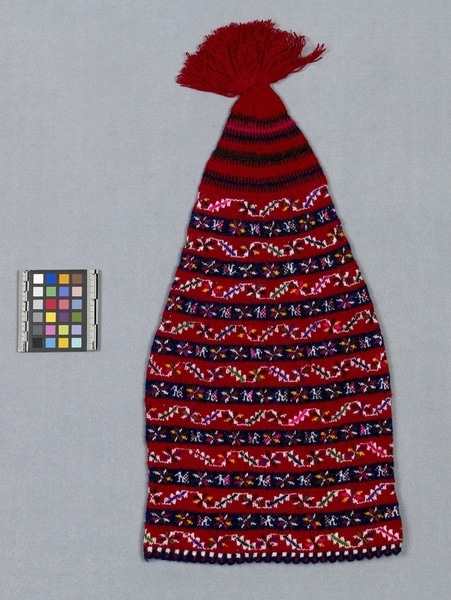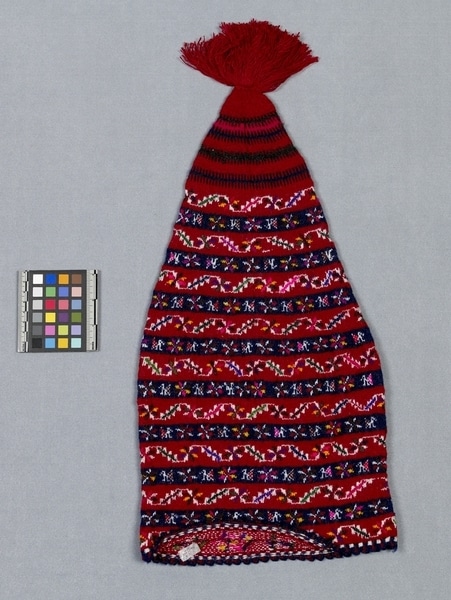Hat Item Number: Sf996 from the MOA: University of British Columbia


Description
Long red stocking cap banded with dark blue. Repeated small scale motifs in white and colours worked against the red and blue bands. Lower edge is scalloped, with two checkered rows above in blue and red and blue and white. At tip is a red yarn tassel. Below the tassel are comb-like bands in blue, green and pink against the red background.
History Of Use
The colour, extent of patterning, shape and the manner in which 'chullus' or caps are worn signifies differences in age, sex and status of wearer. Females wear chullus in early childhood, but only males wear them later in life. Knitting is done only by men and boys, traditionally for chullus, but more recently for vest fronts, coin purses, gloves, ties, vests and sweaters which are sold to tourists. Up until recently, married and single men could be distinguished on the basis of their hat style. Married men wore a totally patterned hat (pentay chullu) and single men wore a half patterned type with a white top (chullu soltero). Today, the pentay chullu is used by married men for special occasions like church, fiestas and weddings. Most men, married or unmarried, wear the chullu soltero for everyday use.
Iconographic Meaning
The comb-like stripes at the top have colour symbolism: green represents the crops, pink, the flowers, and blue, the rain. The flower and stepped diagonal motif is called 'cinta lawar' in Quechua and 'camino y rosa' (road and flowers) in Spanish.
Narrative
Bought from .....Quispe Cruz who made it for himself for the occasion of his wedding in July, 1987. This hat was worn on the second day of his wedding. He knit an almost identical one which he wore on the first day of his wedding.
Specific Techniques
Synthetic commercial yarns are z spun, plied 2-s. Cap is knitted in the round with 5 needles. Worked with inside of cap facing and worked with purl stitch. Extra colours added in local areas. Tassel is sewn on.
Item History
- Made by Domingo Quispe Cruz (Maker) in Taquile, Puno, Peru during July 1987
- Collected by Mary Frame during 1987
- Owned by Domingo Quispe Cruz
- Owned by Mary Frame before November 3, 1987
- Received from Mary Frame (Seller) and Museum of Anthropology Shop Volunteers (Funding source) on November 3, 1987
What
- Name
- Hat
- Identification Number
- Sf996
- Type of Item
- hat
- Material
- synthetic fibre and dye
- Manufacturing Technique
- knitted and sewn
- Overall
- height 54.5 cm, width 25.5 cm
Who
- Culture
- Quechua
- Creator
- Domingo Quispe Cruz (Maker)
- Field Collector
- Mary Frame
- Previous Owner
- Domingo Quispe Cruz and Mary Frame
- Received from
- Mary Frame (Seller) and Museum of Anthropology Shop Volunteers (Funding source)
Where
- Holding Institution
- MOA: University of British Columbia
- Made in
- Taquile, Puno, Peru
When
- Creation Date
- during July 1987
- Collection Date
- during 1987
- Ownership Date
- before November 3, 1987
- Acquisition Date
- on November 3, 1987
Other
- Item Classes
- textiles
- Condition
- good
- Accession Number
- 1274/0042